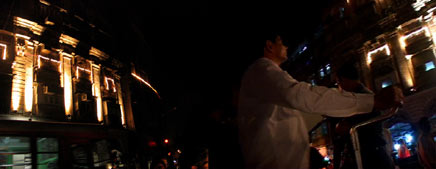| Glow Positioning
System:
At the General Post Office intersection,
Mumbai. January 2005.
view
quicktime
A 1000- foot ring of lights circumscribes the GPO/ Kabutarkhana
chowk (intersection). The lights are installed in a continuous
loop: bridging the roads, connecting trees to buildings, and
lighting up the buildings themselves. People on the street can,
using a hand-crank, illuminate this "path".
The ring responds to panoramic desire, that
age-old search for an image to immerse our selves in. From Cycloramas
to VR (via the tradition of urban panoramas in painting and
photography), the "surround view " has been a recurring
element of urban and cinematic manifestoes. Of course, the city
surrounds us already. Here we just connect the dots.
In any city, various forms of lighting create a distinct nighttime
experience - floating us away from from the concrete views of
daylight. In India, this is a pervasive medium- think of Diwalis
in the city, or weddings, for example. Chases, bursts and strobes
provide moving effects, and represent a vivid transarchitecture.
"Chinese" string lights - they cost about $2 for 14
feet - have made a nighttime "presence" feasible for
almost anybody. For this project, such lights (and others) were
installed on the facades and rooftops (and sometimes interiors)
of several homes , a real-estate office, a razor-blade manufacturer's
office, a transit lodge, an abandoned bank, several shops and
restaurants, and a 100-year old heritage structure (the GPO).
Often, the residents or property owners determined the design
of the lighting.
The lights are then connected in a visual loop, which optically
"relocates" the various sites relative to each other,
to the chowk and the pedestrian in it.
The interface for this project is a hand-crank, mounted on
the pavement near the Kabutarkhana (pigeon coop) . As you turn
the crank, the lit part of the ring of lights moves, for example
from the Kothari building onto the trees, or from one minaret
to the next. Changing the speed of rotation causes variable
persistence effects (both actual and perceived). This is then
a virtual landscape, being animated by its viewers.
Global Positioning Systems imply that we will travel, globally.
In our GPS, "tourism" is an in-situ virtual experience,
relying on the fading of the actual landscape with nightfall.
The experience does not depend on the observer being physically
displaced. Yet there is the clear indication of a map, and the
promise of a haptic journey.

The crank here references its roots in early and pre-cinema,
as the mechanics behind the "moving image". For example
in the moving panorama, and in an entire era of hand-cranked
motion pictures. The crank also mimics a kind of public utility
"key", like the tool you need to open a water connection
box on the road. This entire project is a kind of poetic infrastructure,
a layer on top of the urban design and conservation Plans that
define "inner city" precincts. In a playful and accessible
way, it attempts to rewire the use-based definitions (post office,
eating, shopping, etc) of this public space. - Sukumaran
<back.
|